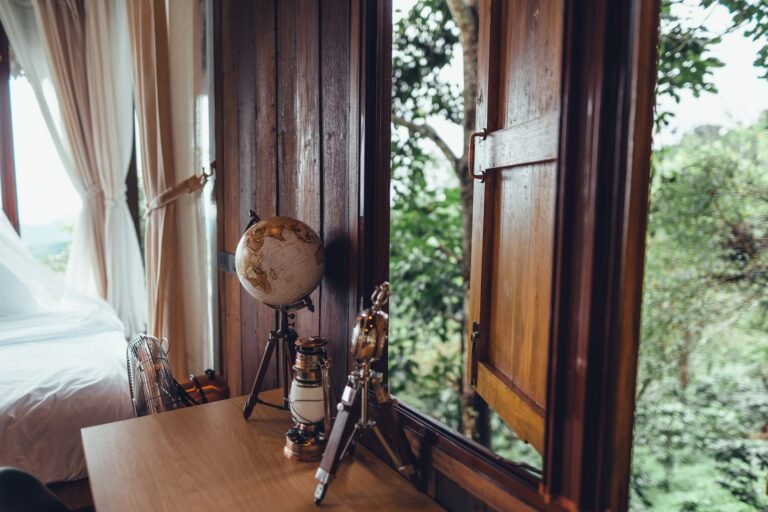Travel changes people in subtle and profound ways. It provides new perspectives, sparks creativity, and broadens understanding of comfort and beauty. When travelers come home, their experiences often influence how they shape their spaces and daily routines. A lifestyle inspired by travel isn’t about gathering souvenirs; it’s about creating environments that tell a story and encourage meaningful living.
This idea resonates deeply within design culture. People no longer see travel as a rare luxury; it has become a way to express identity and values. Homes now display the colors of markets visited, the textures of far-off landscapes, and the tranquility found in new surroundings. A traveler with a design mindset learns to infuse the essence of their journeys into everyday life, blending adventure with comfort.
The Link Between Travel and Personal Aesthetics
Every place leaves an imprint on the senses. The soft light of the Mediterranean, the geometric tiles of Morocco, and the natural colors of the Arizona desert all influence how we perceive color and shape. Designers often refer to this as cultural layering, where travel adds elements that later impact home design and lifestyle choices.
Frequent travelers develop an eye for authenticity. They value materials with history, craftsmanship, and purpose. A handmade rug from a small village, a ceramic cup from a local artisan, or a vintage photo from a street market becomes part of a story that extends beyond its purchase. Each item enriches a space instead of creating clutter.
Incorporating these experiences into daily life promotes a slower, more thoughtful approach to consumption. Instead of populating a room with trends, travelers populate it with memories and emotions. Their surroundings transform into a collection of experiences, a living gallery that evolves with each new destination.
Living Light and Traveling Freely
One lesson that frequent travelers learn is how to live with less. Packing efficiently, prioritizing essentials, and appreciating quality over quantity become natural habits. These principles also translate to how they organize their homes.
A simplified environment reflects intentional design and encourages peace of mind. It frees travelers to set off for new adventures without the stress of clutter or chaos at home. For families and individuals who love to explore while maintaining a home base, good organization is vital.
For instance, those managing seasonal items or personal collections between trips often utilize storage solutions to keep belongings safe while traveling. This approach allows for freedom without compromise. It protects possessions while keeping them accessible, enabling the home to remain inviting, functional, and inspiring. Streamlined living supports both design and mobility.
A well-organized home makes travel spontaneous rather than stressful. It ensures the focus stays on exploration and creativity, rather than logistics.
Key Ways Travel Enhances Home Design
- Natural light and open spaces: Exposure to different architectural styles encourages travelers to recreate the openness they experience elsewhere. Large windows, minimalist furniture, and earthy tones bring the calm found in well-designed villas and resorts.
- Cultural storytelling: Art, textiles, and handmade décor reflect the spirit of exploration. Thoughtfully displaying travel pieces on an accent wall or through curated shelving creates a personal narrative.
- Outdoor integration: Many global destinations celebrate outdoor living. You can design patios, terraces, and gardens to reflect this lifestyle, with greenery and seating areas that mimic serene getaways.
These practices enhance beauty and enrich daily life.
The Emotional Impact of Design Rooted in Travel
The connection between travel and design goes beyond appearance; it also influences emotional well-being. Bringing the tranquility of a coastal town or the vibrancy of a busy city into your home recreates the feelings you experienced there. The outcome is a space that feels alive and personal.
A travel-inspired interior serves as motivation during workweeks, a retreat after long days, and a gentle reminder that life is bigger than any single routine. It connects adventure with a sense of belonging.
Many designers describe this effect as emotional architecture—spaces designed not just for living but for feeling. Incorporating travel memories into your home reminds you of the growth and perspectives gained abroad, offering comfort and continuity.
Designing for Flexibility and Exploration
- Modular décor: Movable shelving, folding furniture, and lightweight textiles enable homeowners to frequently rethink their spaces, reflecting the adaptability of travel itself.
- Neutral base, global accents: Keeping a foundation of neutral colors makes it easy to switch out cultural or seasonal décor, similar to how travelers refresh their wardrobes with each new destination.
- Multi-functional rooms: A guest room that also serves as a reading space or studio can adapt to life’s changing rhythms, just as travelers adjust to new environments.
These ideas foster openness and creativity that lasts even when you are not traveling.
How Travel Encourages Mindful Consumption
Another valuable lesson from travel is learning to value sustainability and craftsmanship. When people visit small artisan markets or family-owned workshops, they start to see the importance of handmade, ethical products. This understanding influences how they decorate and shop once they return home.
A mindful traveler knows that every object has a story. Choosing local crafts over mass-produced décor supports cultural preservation and environmental responsibility. It also connects the home to a broader network of global creativity. Each purchase becomes a tribute to the culture that inspired it.
Embracing this mindset in interior design cultivates sustainable environments filled with natural fibers, reclaimed wood, and meaningful textures. The result is a space that feels grounded and ethically sound, marrying beauty with integrity.
Creating Travel-Inspired Routines at Home
Even when not traveling, you can create daily rituals that reflect the mindfulness of travel. Start mornings with practices that mirror your favorite places: slow breakfasts with fresh fruit and local coffee or time spent journaling beside sunlight filtering through sheer curtains.
Travelers often notice that time slows down while they are away. You can recreate this sense of spaciousness at home by designing cozy corners that invite relaxation—a reading nook, a window bench, or an outdoor chair surrounded by plants. Simple routines like lighting incense, playing soft background music, or enjoying meals without screens bring the same sense of wonder you experience abroad.
Home becomes more than just a resting place; it serves as a daily reminder of global connection. The design of your surroundings shapes how you experience time and emotions.
Balancing Mobility and Belonging
For those whose work or lifestyle involves frequent travel, establishing a base that feels stable yet flexible is vital. Creating a home that welcomes both departure and return ensures emotional balance. This often includes investing in durable furniture, low-maintenance materials, or modular storage that makes transitions easy.
A well-organized home offers a sense of belonging, even when you are away. When you return, it greets you with familiarity and warmth. The objects and layouts reflect your story, grounding you in comfort while reminding you of your travels.
This is why many travelers view home design as self-care. The colors, scents, and textures around you can replenish your energy after long flights or busy schedules. Spaces that evoke nature, culture, or memory connect travelers between adventures.
The Future of Travel-Inspired Design
Design trends increasingly blur the lines between travel, architecture, and lifestyle. Remote work has made mobility more accessible, and homes now serve as both creative spaces and retreats. Furniture designers and architects draw inspiration from global patterns, crafting pieces that fit small areas yet evoke luxury and calm.
Sustainable tourism has also influenced design thinking. Homeowners now seek décor that reflects eco-friendly accommodations, such as energy-efficient lighting, repurposed materials, and indoor plants that clean the air. This shift aligns the traveler’s values with their everyday surroundings.
Travel is not just about moving; it’s about gaining perspective. When you design with global influence and local intent, you create a home that celebrates the best of both worlds.
Carrying the Journey Home
Design and travel share a fundamental connection—curiosity, emotion, and discovery. A well-designed space captures the essence of exploration long after the suitcase is unpacked. Whether through a color palette that evokes the desert or furniture that reminds you of a seaside escape, home becomes a changing reflection of life’s adventures.
Living as a design-minded traveler means creating spaces that invite connection, creativity, and calm. This approach values simplicity, sustainability, and storytelling over perfection. In doing so, every corner of your home becomes part of a larger map, guiding you not just to distant places but also back to yourself.


































